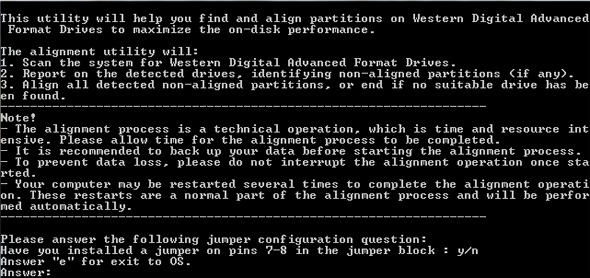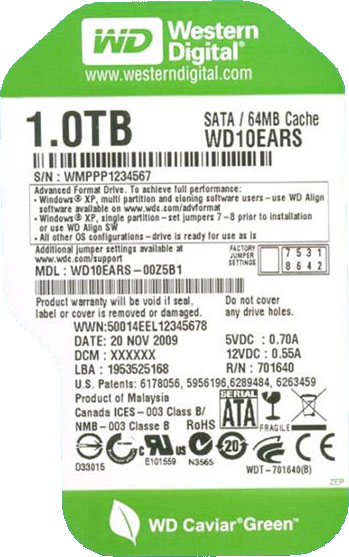Western Digital’s Advanced Format: The 4K Sector Transition Begins
by Ryan Smith on December 18, 2009 12:00 AM EST- Posted in
- Storage
What Operating Systems Are Affected
Now that we’ve dealt with what 4K sectors are, why Western Digital and other drive manufacturers are switching to them, and what the potential pitfalls of 512B emulation are, we can look at the specific cases where there are potential problems.
The big problem is that while the first work on 4KB sectors started in 1998, it wasn’t until after the launch of Windows XP that the matter came to a head. As a result the 5.x versions of Windows (2K, XP, 2K3, WHS) have no concept of 4KB sectors. Even though all operating systems will be seeing 512B sectors through the use of emulation technology on the drive controller, out of Windows only Win 6.x (Vista, 2008, Win7) and later have been programmed to take in to account the alignment issues we mentioned earlier. Win 5.xx in particular has a nasty habit of starting the first partition at LBA 63, which is 1 512B sector misaligned from a 4K sector boundary. In essence, the issue is that Win 5.x will always create a misaligned first partition and will have poor default performance as a result.
Although Win 5.x is the primary victim here, other versions of Windows can also be affected in edge cases. Along with the need for 4K-aware operating systems, drive imaging software needs to be 4K-aware. Otherwise such imaging software may inadvertently create misaligned partitions too. As such, Win 6.x is also affected by alignment issues when imaging software is used, as some (and perhaps all?) imaging products currently available will write misaligned partitions and/or clusters.

Notably, Linux and Mac OS X are not affected by this issue. Western Digital has tested both of these operating systems, and officially classifies them as not-affected. Ultimately we suspect that if you went back far enough you could find older versions of these OSes that are affected, but unlike Win 5.xx, there’s not a significant legacy user base to worry about. Along these lines, Linux and Mac OS X drive imaging products are similarly unaffected. In their testing, imaging tools such as SuperDuper didn’t run in to any alignment issues, so Linux and Mac OS X users are not affected in any way by 4K sectors. It’s only Windows and Windows imaging products that are affected.
In order to solve the misalignment issue, Western Digital is offering two solutions. The first solution for correcting misaligned partitions is specifically geared towards Win 5.x, and that is an option on the drive itself to use an offset. Through the jumpering of pins 7 and 8 on an Advanced Format drive, the drive controller will use a +1 offset, resolving Win 5.xx’s insistence on starting the first partition at LBA 63 by actually starting it at LBA 64, an aligned position. This is exactly the kind of crude hack it sounds like since it means the operating system is no longer writing to the sector it thinks its writing to, but it’s simple to activate and effective in solving the issue so long as only a single partition is being used. If multiple partitions are being used, then this offset cannot be used as it can negatively impact the later partitions. The offset can also not be removed without repartitioning the drive, as the removal of the offset would break the partition table.
The second method of resolving misaligned partitions is through the use of Western Digital’s WD Align utility, which moves a partition and its data from a misaligned position to an aligned position. This is the recommended solution for using multiple partitions under Win 5.xx, along with correcting any misaligned partitions generated by imaging software. For that matter we’d consider it the recommended solution for single-partition drives being used under Win 5.x too, as there’s no need to worry about offsets and breaking the partition table.

The utility is available for download from Western Digital’s site, and while it isn’t pretty (it’s a scripted CLI application) it gets the job done. The amount of time needed to run the utility is based on the amount of data that needs to be moved rather than the partition size (it simply ignores empty space), so it’s best to run the utility immediately after creating a partition or installing Windows, as there’s less data to move around.
Unfortunately, at this point the utility also serves as the only way to identify an Advance Format drive without physically looking at it. Looking at the ATA spec, it looks like there’s a provision for asking a drive its native sector size (regardless of 512B emulation) but at this point there’s no such tool beyond the WD Align utility itself. This in and of itself isn’t a big issue, but if you’re a techie that ever finds themselves working on an XP machine with a 1TB+ Western Digital drive, you’ll want to keep an eye open.
The First Drives & The Future
So what are the first Advanced Format drives and when are they due? The first drives will be Caviar Green drives using multiple 500GB platters – so the 1TB, 1.5TB, and 2TB Caviar Green. These drives will be shipping any day now, and can be identified through two different methods: 1) They all have 64MB of cache - the first WD Caviar Green drives to come with that much cache - and 2) They all have EARS in the drive model number, e.g. WD10EARS.

As we stated before, in spite of the benefits of 4K sectors, Western Digital is not pushing these drives as part of any major product launch. Rather they’re going to be quietly trickling in to the marketplace. Expect a price premium at first (as with any other new product) before settling down. We don’t have a drive on-hand to review, but from the fact that this is a low-key launch, WD isn’t painting any expectations of a performance difference, although this will be something to test in the future.
And on that note, expect to see similar launches from everyone else within the next year. The last IDEMA plan called for everyone to have 4K-sector drives by 2011, so everyone should be launching within the next year here. Everyone using 512B emulation is going to run in to the same teething issues with Win 5.x – so while other vendors may handle things slightly differently, ultimately everyone is going to be compensating for Win 5.x in some manner (in case it hasn’t been made clear here, these guys would be ecstatic for Win 5.x to go away quickly).
Farther down the road will be the exposure of 4K-sectors to the operating system itself. Linux and Win 6.x are set (and we believe that Mac OS X is too), the only limit right now is the desire to do a phased transition to make thing easier for legacy users. Since 4K-sector drives won’t work on Win 5.x at all, drive manufacturers can’t put them on the market so long as there’s a significant legacy base. 2014 – the year that extended support ends for WinXP – looks like a good year to finally complete the move to 4K sectors.










86 Comments
View All Comments
mcnabney - Monday, December 21, 2009 - link
My concern is that WHS is kind of designed to last a long time. I don't know what a new build of WHS based upon Server08 is going to offer the consumer. I really envisioned my server staying as it is for a long time, only occasionally adding a drive to the pool as needed. I have a 14-bay case, plus the ability to add external racks, so I have a lot of potential growth. I would prefer not having a headache in 2011 when these drives are the standard. I also don't see the need to upgrade/replace my server until the hardware dies. It isn't like an OS that you use every day that can always use a revision.DanNeely - Friday, December 18, 2009 - link
Also. Has MS released any major core OS updates to WHS since the rest of windows 5.x went onto extended support? Patches to things that are WHS specific don't count. I'm asking about features that are/should be common with XP/2k3.DanNeely - Friday, December 18, 2009 - link
I wouldn't hold my breath. The HW companies have work around's available even if they're suboptimal; and WHS has a fairly small userbase to justify a major engineering effort. Especially since a new version of WHS based on server 08 is rumored to be coming next year and patching the current WHS would only draw attention to not patching XP/server 2k3.azmodean - Friday, December 18, 2009 - link
Yes, there would be HUGE issues throughout the file system stack, and also bleeding over into page table management, memory management, DMA, drivers, and who knows what else. It's not a simple fix at all, and even if they weren't halting support for winXP, I doubt they'd be willing to make the necessary changes.Linux went through this process a while back, and it was a very extensive set of changes even though Linux was more modular than windows to start with.
mczak - Friday, December 18, 2009 - link
We're not talking about making XP 4K blocks aware, but simply let it create partitions aligned on 4K boundaries. This would be a trivial fix. But yes it's not a security issue so no luck.btw I wonder what the performance is like if partition is unaligned. Noone tested?
ppelleg - Sunday, February 21, 2010 - link
Yes... and it was terrible!!!After aligning the stuff using WD Align (the WD utility) the problem was solved and I get back performances...
evalfi - Monday, April 12, 2010 - link
I installed XP SP3 on an older master drive (40GB)Then from XP I choose to format the WD10EARS slave drive in logical sectors of 4K.
Will it still be necessary to run the alignment tool on this Drive?
Greetz & Thanks
ken1945 - Saturday, April 17, 2010 - link
Does anyone know if WD 4K drives that were originally formatted on a Mac using OSX, will have any alignment problems when running XP on that Mac under Bootcamp, VM Fusion, Parallels, etc?FYI, I remember back in the late 1970s when Wang transitioned from 256B sectors to 1K blocks when their hard drive storage cabinets (the size of a small desk!) increased to 80MB. No transition problems except for hernias.
MrCyberdude - Tuesday, May 11, 2010 - link
What a nightmare these WD20EARS drives have given me with the 4k cluster overlap.The ReadyNas Pro speed is down to 1/5th the speed of 22MB/sec write. when tested with Bonnie++ and actual file copies.
A complete joke that WD states that it does not support Linux.
A complete Joke that Netgear has not tested these drives and got them working with their product as they are a Major HDD supplier.
http://www.readynas.com/forum/viewtopic.php?f=24&a...
MrCyberdude
mfreesto - Sunday, September 12, 2010 - link
So how will 4K affect RAID set ups? I setup several WD 20EARS drives in RAID 5, and of course Win7 only sees one' drive'. Has the RAID controller correctly aligned the drive?The WD Align tool is no use as it sees the RAID array as a non-WD drive.
This is using the built in nVidia RAID on an Asus M3N78-EM. nVidia is silent on the issue, and the WD website doesn't discuss RAID in the context of AFT.
Anyone got any insights?